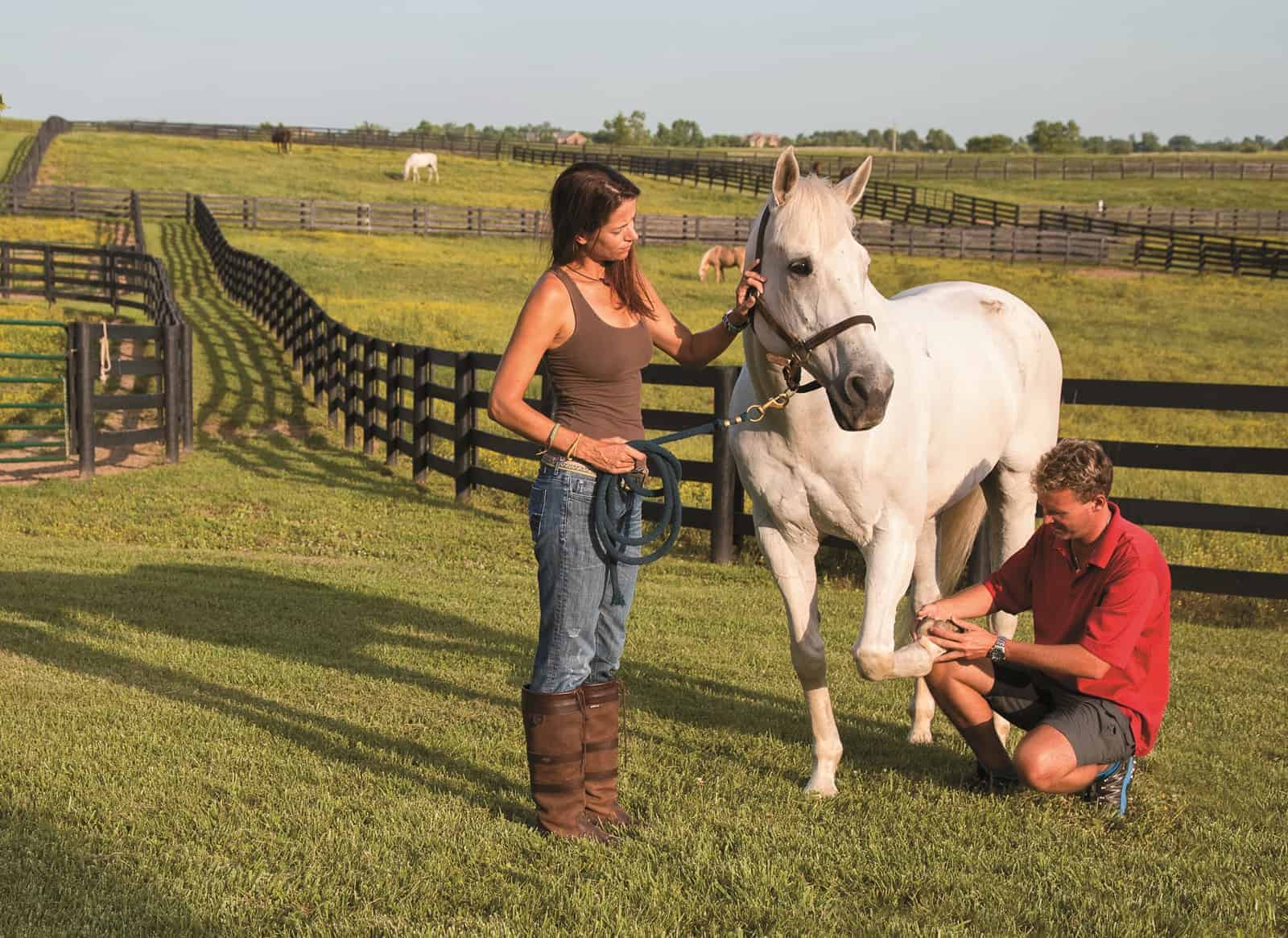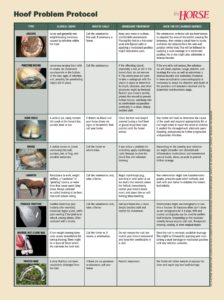Hoof-Care Triage
- Topics: Abscesses, Article, First Aid, Fractures, Hoof Care, Laminitis (Founder), Puncture Wounds

But First, One That’s Not as Bad as It Looks
A chunk of hoof missing or a crack resembling the Grand Canyon looks awful, but the damage might be mostly cosmetic, says Patrick Reilly, chief of farrier services at the University of Pennsylvania’s New Bolton Center, in Kennett Square.
“The questions to ask yourself are: Is there blood? What is the horse’s comfort level?” says Reilly. “If there’s no blood and the horse is not showing signs of discomfort, then definitely call your farrier, but it’s probably not an emergency.”
You don’t want the hoof condition to deteriorate further in the meantime, however, so Reilly recommends cleaning the foot and keeping it covered until the farrier arrives. (Try a hoof-wrap “bootie” or that old standby—some sort of gauze/diaper/self-adhesive wrap/duct-tape combo.) Keep your horse quiet, out of mischief, and out of wet, yucky, wrap-sucking footing.
One caveat here, from Reilly’s New Bolton Center colleague, staff surgeon David Levine, DVM, Dipl. ACVS: “People can focus so much on the obvious injury that they forget to check for other problems. In this case, what happened to cause the horse to rip off a piece of his foot so badly? Did he get a leg caught in something?” The horse could have sustained injuries elsewhere—so if any signs of pain or lameness crop up, have your vet check him over.
Puncture Wounds
If there’s a sharp, sturdy object lying around, chances are it’s going to find its way into some hapless horse’s foot. Horses pull their own shoes all or part way off and can step on the nails or other pieces of debris—stray screws, roofing nails, even pieces of wood.
If the object has penetrated the sole of the foot, the horse will be very lame, Reilly says. “If you see the nailhead, your first instinct is to pull it out, but you’re better leaving it in place unless doing so is going to drive the nail in further and make the injury worse,” he advises.

The problem with removing the offending object is twofold. First, removing the object means the veterinarian—yes, you must call the vet in addition to the farrier, Reilly says—won’t be able to use radiographs (X rays) to see which internal structures are affected. Second, when the object is removed, the puncture site seals itself (and any introduced bacteria) off and, as a result, Levine says, “the structures underneath can slowly fester.” It’s especially ominous when the object has penetrated the posterior part of the foot—from frog to heels—because that’s where the navicular bone and bursa, coffin bone and joint, and digital flexor tendon sheath reside, he says. Serious damage, infection, or both in those structures can spell surgery, a career’s end, or even a horse’s demise.
Horseshoeing nails generally aren’t the culprit in serious infections, says Reilly, who points out that farrier nails “aren’t usually long enough to get into the navicular bone or other at-risk structures.”
Until help arrives, restrict your horse’s activity and keep him as comfortable as possible—preferably in a clean, deeply bedded stall, Levine says. If you’ve decided that it’s best to leave the penetrating object in the foot, protect the sole from further trauma if you can. Reilly recalls a case in which one clever owner taped a block of wood to the bottom of the horse’s foot to prevent the nail from wiggling loose and causing additional damage.
Three-Legged Lameness
Let’s say there’s no nail or other obvious culprit, but your horse refuses to bear weight on one foot. What’s going on? “When there’s a sudden non-weight-bearing lameness, usually just in one foot, it’s usually a fracture or an abscess,” says Reilly, both of which warrant summoning both the veterinarian and the farrier. (But “if your horse got new shoes today and he’s non-weight-bearing tomorrow, start with the farrier,” he adds. The farrier may have “quicked” the horse with an ill-placed nail.)
An abscess, Reilly explains, is an infection within the hoof that can be caused by dirt or debris working up through areas of the foot. “It can be a bruise—a pocket of blood and serum that gets infected,” he says. “The body mounts an inflammatory response, and there’s nowhere for the pressure to go. It’s very painful.”
The infection itself can be in or between the laminae (the layers of sensitive tissue connecting the coffin bone to the hoof wall), Reilly says. Either way, the pain is excruciating—like having an infection underneath your fingernail.
Treating an abscess usually involves opening the affected area, allowing the pus and gunk to drain (which relieves the pressure and, therefore, the pain), soaking the foot to draw out the any remaining infection, keeping the foot clean and covered, and administering oral or topical antibiotics. Abscess resolution is time-consuming, but Reilly and Levine would rather see such a case than a fracture.
A coffin-bone fracture is not uncommon and can be career-ending, according to Reilly—and that’s why it’s important to get the veterinarian out to assess the lameness. Unless there’s fairly obvious sole bruising, you won’t know what you’re dealing with until the veterinarian assesses radiographs, which will reveal fractures and some abscesses.
Before your health-care team arrives, get your horse into a clean, deeply bedded stall or restrict his movement somehow, Reilly advises. Don’t soak the foot, as “it could make diagnosis harder,” he says.
Laminitis
Levine finishes by describing laminitis—inflammation of the hoof’s laminae. He simply sighs about the dreaded disease.
“It’s bad,” he says.
Unlike an abscess or a fracture, laminitis typically appears gradually, and it usually affects pairs of feet or even all four. Reilly and Levine rattle off the possible warning signs: stiffness and hesitation to walk, weight shifting, an exaggerated or otherwise abnormal gait, “pointing” a foot (standing with one foot extended forward so it bears less weight), a “sawhorse” stance, standing “like an elephant on a ball” (with all four feet abnormally close), or more time than usual spent lying down.
In a suspected case of laminitis, early intervention is key, he says. This is another scenario in which you want to summon both the veterinarian and the farrier.
While you’re waiting for help to arrive, “start cryotherapy ASAP,” Reilly advises. Put bags of ice on your horse’s feet; stand him in cold creek water; do whatever you can to try to draw heat and inflammation out of the feet. Restricting your horse’s movement likely won’t be a problem inasmuch as he’s reluctant to move in the first place, but get him on soft footing to make him as comfortable as possible.
If Levine sees a horse for suspected laminitis, he wants to hear about recent changes or issues that might have affected the horse. So if you’ve changed feed recently, increased or decreased pasture access, or if your horse has suffered any illness or injury, let your veterinarian know.
“Teamwork between the vet and the farrier is especially important in cases of laminitis,” Levine adds. “It’s helpful for the farrier to see the radiographs” to assess sole thickness and the position of the coffin bone before undertaking any mechanical pain-relief measures, such as corrective trimming and shoeing, he says.
Take-Home Message
Sure, almost anyone can spot a dead-lame horse, but sometimes signs are more subtle. You know your horse better than anyone; if something seems out of the ordinary, get it checked—you don’t want to take any chances with your horse’s feet.
Get a good, teamwork-oriented farrier and veterinarian on your horse-care team well in advance of any emergencies. This is useful not only for practical reasons (not every practitioner makes emergency calls for nonclients) but also for establishing some benchmark data, which can prove useful for comparison in the face of a crisis.
Written by:
Jennifer O. Bryant
Related Articles
Stay on top of the most recent Horse Health news with















